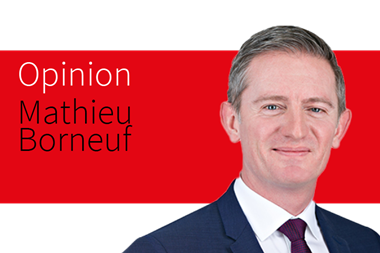There has been a correction in the D&O market post-pandemic, but this has not been seen across the board, says senior underwriter
As the anniversary of the renewals that saw directors and officers (D&O) premiums undergo shocking and significant falls approaches, underwriters and brokers believe the sector is on a knife edge.
Intensifying competition is putting further pressure on premiums at a time when the economic outlook threatens a wave of insolvencies and the ongoing focus on environmental, social and governance (ESG) rules present new risks for underwriters.
The D&O market has been through a period of transition as the withdrawal of capacity and past increases in premium costs have been tempered by the arrival of new capacity and the increased competition for risks.
Broker Aon released its Market dynamics outlook report this summer (30 August 2022), in which it revealed that rates for D&O insurance had decreased in Q2 2022 because of “increased competition, both in terms of new capacity from insurers and MGAs and a broadening of appetite from existing insurers.”
Paul Perry, senior underwriter at QBE, said the talk of plunging premiums was wide of the mark, however.
“During the COVID pandemic there were certain areas of business that were under particular pressure and cover was priced accordingly,” he explained.
“As we emerged from the pandemic and the outlook become more positive, we have seen a correction in some areas of the D&O market, but we have not seen a wholesale reduction across the board.
On the arrival of new capacity, Perry said any competition must be welcomed, but added that D&O is a long tail business and there needed to be a sustainable approach to underwriting and pricing.
Unique shock
However, Sarah McGurk, senior management liability underwriter for global corporate and specialty at Aviva, said the shock to the market has been unlike any other.
“There is a great deal of uncertainty in the market at present,” she added.
“It is so unusual to come off such a hard market and to have such a heavy landing without any plateau in between.”
McGurk, who sits on the International Underwriting Association’s D&O Committee, said that while prices have fallen significantly, the underlying risks have not.
“The claims are still there,” she explained. “While there has been a drop in US class actions, we are still seeing claims. We are not out of the woods.”
She explained underwriters were facing a battle with new capacity that was unincumbered by prior claims and, as such, was well aware they could beat the quotes from established markets.
“Actuaries are saying they want to see premium rates maintained or increased to offset the claims which are being made, but we are in a situation where we are simply seeking to remain in risks,” McGurk said.
Unpredictable
For their part, brokers say the unpredictability in the approach from underwriters means the market is still a tough one to navigate.
Eve Richards, UK head of finex D&O at Willis Towers Watson, said competition is putting pressure on pricing across the market with the excess layers particularly hard hit.
She said that 37% of her primary clients had reported a flat premium or reductions in renewals, while the figure was above 60% in the excess lines.
This has seen underwriters looking to quote for more volatile risk as they seek to meet their premium income targets.
“There is significant capacity for all areas of the market but it remains unpredictable,” Richards explained.
“We have seen quotes for risks that in the past would not have been within the risk appetite of the underwriters.
“We will fully remarket the risks on behalf of our clients where they have seen an increase at renewal. We want to see how we can deliver the best results.”
She said buyers were looking to buy less cover and – coupled with the influx of capacity, both from the new entrants and from established players seeking to grow their book – supply was now heavily outweighing demand.
Managing expectations
The anniversary of the renewal season that saw the fall in premiums is approaching and Steve Bear, executive director for D&O at Gallagher, said the issue for the brokers was to manage expectations.
He explained: “Last year we saw reductions of 30% to 40% and I think this year pricing will have levelled off.
“We are talking to clients who may be expecting a similar situation at this year’s renewals to say that it is unlikely to see those type of rate reductions unless it is in classes which were hit heavily by the pandemic and were rated as such.
“The market is looking to find the new normal – the new base line. It will not be at the levels pre-2016, but it will also not be at the levels we have recently seen when the market was at its peak.
“Clients want a stable market. They are not happy with the volatility in premiums where they may see a 30% reduction then face a 70% increase.”
However, Bear said that while established underwriters have been looking to stress the value of the relationships with broker and clients, relationship can be less of a draw for some insureds.
“Insurers have been quick to stress they were there for clients during the pandemic, but some clients – while recognising their underwriter was with them – also [saw] premiums increase massively.
“We are seeing clients who may have undergone a merger or acquisition using the new entity as an excuse to start with a clean slate when it came to their D&O provider.”
ESG concerns?
While competition is impacting pricing the market is still facing a range of risks, with ESG seen as a future threat.
The legal and regulatory focus on ESG has caused some concern for underwriters.
However, Angus Duncan, executive director and D&O coverage specialist at WTW, said while some insurers including AIG had begun to introduce ESG questionnaires as part of the underwriting process, there is no uniform move to do this.
“There is talk around ESG in the UK market, but at present it is just talk,” he said.
“The risks that are deemed to be ESG related are already covered by insurers so ESG is discussed but not really acted upon as yet.”
He added that, at present, if questions are asked, it was very much up to the client as to the information they were happy to impart.
“In term of ESG, it is difficult to see where or when it will land,” Perry said.
“The market is in its infancy. Most clients’ strategies are set for 2035-40 so the risks are really around their failure to meet those targets or the interim targets within those strategies.”




















No comments yet